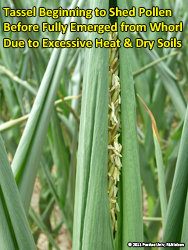17 June 2012
URL: http://www.kingcorn.org/news/articles.12/Hurdle-0617.html
Next Big Hurdle: Pollen Shed and Silking
R.L. (Bob) Nielsen
Agronomy Dept., Purdue Univ.
West Lafayette, IN 47907-2054
Email address: rnielsen
at purdue.edu
![]() t remains to be determined whether the 2012 drought will achieve a lofty position in the Drought Hall of Fame for Indiana corn growers alongside some of the previous "great" droughts like those of 1983, 1988, and 1991. The storms that rolled through Indiana late in the day Saturday appeared to have dropped several inches of rain in a small area of northwest Indiana, but much of the state was left without much measureable precipation.
t remains to be determined whether the 2012 drought will achieve a lofty position in the Drought Hall of Fame for Indiana corn growers alongside some of the previous "great" droughts like those of 1983, 1988, and 1991. The storms that rolled through Indiana late in the day Saturday appeared to have dropped several inches of rain in a small area of northwest Indiana, but much of the state was left without much measureable precipation.
Given the drought or near-drought status of much of the state and the poor prospects for wide-spread soaking rainfall in the near future, the pending arrival of the critical pollination period for the Indiana corn crop is of concern to many corn growers right now. That concern is well-grounded because success or failure of the important flowering period for the corn crop greatly impacts the potential for yield at harvest.
Severe drought stress can impact the pollination process in several ways. The effects are particularly likely to occur if the severe drought is accompanied by excessive heat and if corn fields have been subjected to drought stress in the days or weeks preceding the onset of the flowering period.
One of the negative consequences is the possible disruption of the synchrony between the appearance of receptive silks from the ears (Nielsen, 2010a) and the availability of pollen from the tassels (Nielsen, 2010b). Severe drought stress can delay the emergence of the silks from the tips of the husks by slowing the elongation rate of the silks. If the delay is too great, silks emerge after most or all of the available pollen has already been shed from the tassels. The result can be barren or nearly barren ears. Unfortunately, tassel development and maturation often occurs more quickly under drought stress and pollen sometimes is shed prematurely; further excaberating the problem of delayed silk emergence. Delayed silks not pollinated will continue to elongate until they deteriorate, resulting in unusually long silks (Nielsen, 2009).
Another consequence of severe drought stress on the pollination process, especially if accompanied by excessive heat, is that exposed silks may desiccate and become non-receptive to available pollen being shed by the tassels. Pollen "grains" cannot germinate on dried, exposed silks and, thus, will fail to fertilize the ovules connected to the silks. Again, the result can be barren or nearly barren ears.
Another consequence of severe drought stress is that tassels may not fully emerge from the final leaves of the upper whorl due to restricted elongation of the tassel or uppermost stalk internodes. Such failure to emerge completely from the whorl leads to pollen shed occurring within the whorl instead of into the open air. If too much of the pollen remains "trapped" within the whorl for too many tassels throughout a field, there may not be enough pollen left for successful pollination.
![]() Watch video about drought & pollination.
Watch video about drought & pollination.
Even if pollination occurs successfully, severe drought stress that continues into the first week or two after pollination may cause newly-formed kernels to quickly abort (Nielsen, 2011a, 2011b). Moderate stress often results in barren tips of ears because those kernels are usually last to form (i.e., those ovules are last to be fertilized by pollen). Severe stress may result in scattered kernel set throughout the ear or odd patterns of kernel abortion like the so-called "zipper" pattern (Nielsen, 2011b).
Related Reading
AHPS Precipitation Analysis. 2012. National Weather Service, http://water.weather.gov/precip/ [URL verified June 2012].
Midwest Climate Watch. 2012. http://mcc.sws.uiuc.edu/cliwatch/watch.htm [URL verified June 2012]
Nielsen, RL (Bob). 2009. Unusually Long Silks in Corn. Corny News Network, Purdue Univ. http://www.kingcorn.org/news/timeless/LongSilks.html [URL verified June 2012]
Nielsen, RL (Bob). 2010a. Silk Development and Emergence in Corn. Corny News Network, Purdue Univ. http://www.kingcorn.org/news/timeless/Silks.html [URL verified June 2012]
Nielsen, RL (Bob). 2010b. Tassel Emergence & Pollen Shed. Corny News Network, Purdue Univ. http://www.kingcorn.org/news/timeless/Tassels.html [URL verified June 2012]
Nielsen, RL (Bob). 2011a. Kernel Set Scuttlebut. Corny News Network, Purdue Univ. http://www.kingcorn.org/news/timeless/KernelSet.html [URL verified June 2012]
Nielsen, RL (Bob). 2011b. The "Zipper" Pattern of Poor Kernel Set in Corn. Corny News Network, Purdue Univ. http://www.kingcorn.org/news/timeless/Zipper.html [URL verified June 2012]
Nielsen, RL (Bob). 2012. A Fast & Accurate Pregnancy Test for Corn. Corny News Network, Purdue Univ. http://www.kingcorn.org/news/timeless/EarShake.html [URL verified June 2012]
US Drought Monitor. 2012. National Drought Mitigation Center. http://droughtmonitor.unl.edu [URL verified June 2012]


